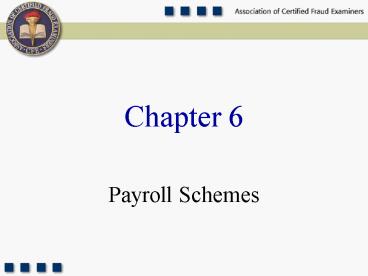Payroll Schemes - PowerPoint PPT Presentation
1 / 26
Title:
Payroll Schemes
Description:
Ghost Employees. Someone on the payroll who does not actually work for the victim company ... Preventing and Detecting Ghost Employee Schemes ... – PowerPoint PPT presentation
Number of Views:399
Avg rating:3.0/5.0
Title: Payroll Schemes
1
Chapter 6
- Payroll Schemes
2
Payroll Schemes
Ghost Employees
Commission Schemes
Workers Compensation
Falsified Wages
3
Frequency of Fraudulent Disbursements
Payroll
4
Median Loss of Fraudulent Disbursements
Payroll
5
Dollar Loss Payroll Schemes
6
Detection of Payroll Schemes
7
Perpetrators of Payroll Schemes
8
Median Loss by Perpetrators Position
9
Payroll Schemes by Number of Employees
10
Size of Victims Payroll Schemes
11
Payroll Schemes
- Occupational frauds in which a person who works
for an organization causes that organization to
issue a payment by making false claims for
compensation - Ghost employee schemes
- Falsified hours and salary schemes
- Commission schemes
12
Ghost Employees
- Someone on the payroll who does not actually work
for the victim company - Fictitious person
- Friend or relative
- Accomplice
13
Ghost Employee Schemes
- Adding the ghost to the payroll
- Through the personnel department
- Through the hiring department
- Through the payroll department
- Using names similar to real employees
- Failing to take terminated employees off the
payroll
14
Ghost Employee Schemes
- Collecting timekeeping information
- Fake timecards
- Approval of timecards
- Computerized timekeeping systems
- Salaried workers vs. hourly workers
15
Ghost Employee Schemes
- Issuing the ghosts paycheck
- Delivery of the paycheck
- Hand delivered
- Mailed to the employees address
- Direct deposited
16
Preventing and Detecting Ghost Employee Schemes
- Separate the hiring function from the payroll
function - Personnel records should be independently
maintained from payroll and timekeeping functions - Personnel department should verify any changes to
payroll - Background and reference checks should be made in
advance of hire
17
Preventing and Detecting Ghost Employee Schemes
- Periodically run computer reports for employees
- Without SSNs,
- With no deductions - withholding taxes or
insurance - With no physical address or telephone number
- Compare payroll expenses to production schedules
- Keep signed checks in a secure location
- Payroll checks should not be distributed by
someone with hiring authority - Verify proper distribution and require employee
identification - Any dual endorsements of cancelled checks should
be viewed with skepticism
18
Falsified Hours and Salary
- Overpayment of wages is the most common form of
misappropriating payroll funds - Increase number of hours or hourly rate of pay
19
Manually Prepared Timecards
- Forging a supervisors signature
- Collusion with a supervisor
- Rubber stamp supervisors
- Poor custody procedures
20
Other Schemes
- Time clocks and other automated timekeeping
systems - Employee has someone else clock in for him when
absent - Rates of pay
21
Example Falsified Hours
- Jen falsely claimed an average of 10 hours of
overtime per week. She approved her own time
cards and forwarded them to the payroll
department. Jen was caught when payroll noticed
that she had claimed overtime in a period where
no overtime was allowed.
22
Preventing and Detecting Falsified Hours and
Salary Schemes
- Preparation, authorization, distribution, and
reconciliation should be segregated - Transfers of funds from general accounts to
payroll accounts should be handled independently - No overtime paid unless authorized in advance
- Sick leave and vacation time should not be
granted without supervisory review and monitored
for excessive time taken
23
Preventing and Detecting Falsified Hours and
Salary Schemes
- A designated official should verify all wage rate
changes - Timecards should be taken directly to the payroll
department after approval - Monitor fluctuations in payroll expense
24
Tests for Fraudulent Payroll Activity
- Run programs to actively seek out fraudulent
payroll activity - Review employees who have significantly more
overtime than similar employees - Trend analysis of budgeted vs. actual expenses
- Exception reports for employees who have had
disproportionately large increases in wages - Verify payroll taxes equal federal return tax
forms - Compare net payroll-to-payroll checks issued
25
Commission Schemes
- Pay is based on an employees output rather than
hours worked or a set salary - Falsify the amount of sales made
- Creation a fictitious sale
- Overstate legitimate sales
- Claim a sale made by someone else as your own
- Fraudulently increase the rate of commission
26
Detecting Commission Schemes
- Run periodic reports to show an unusual
relationship between sales figures and commission
figures - Run reports that compare commissions earned among
salespersons - Track uncollected sales generated by each
salesperson - Conduct random samples of customers to verify
that the customer exists































